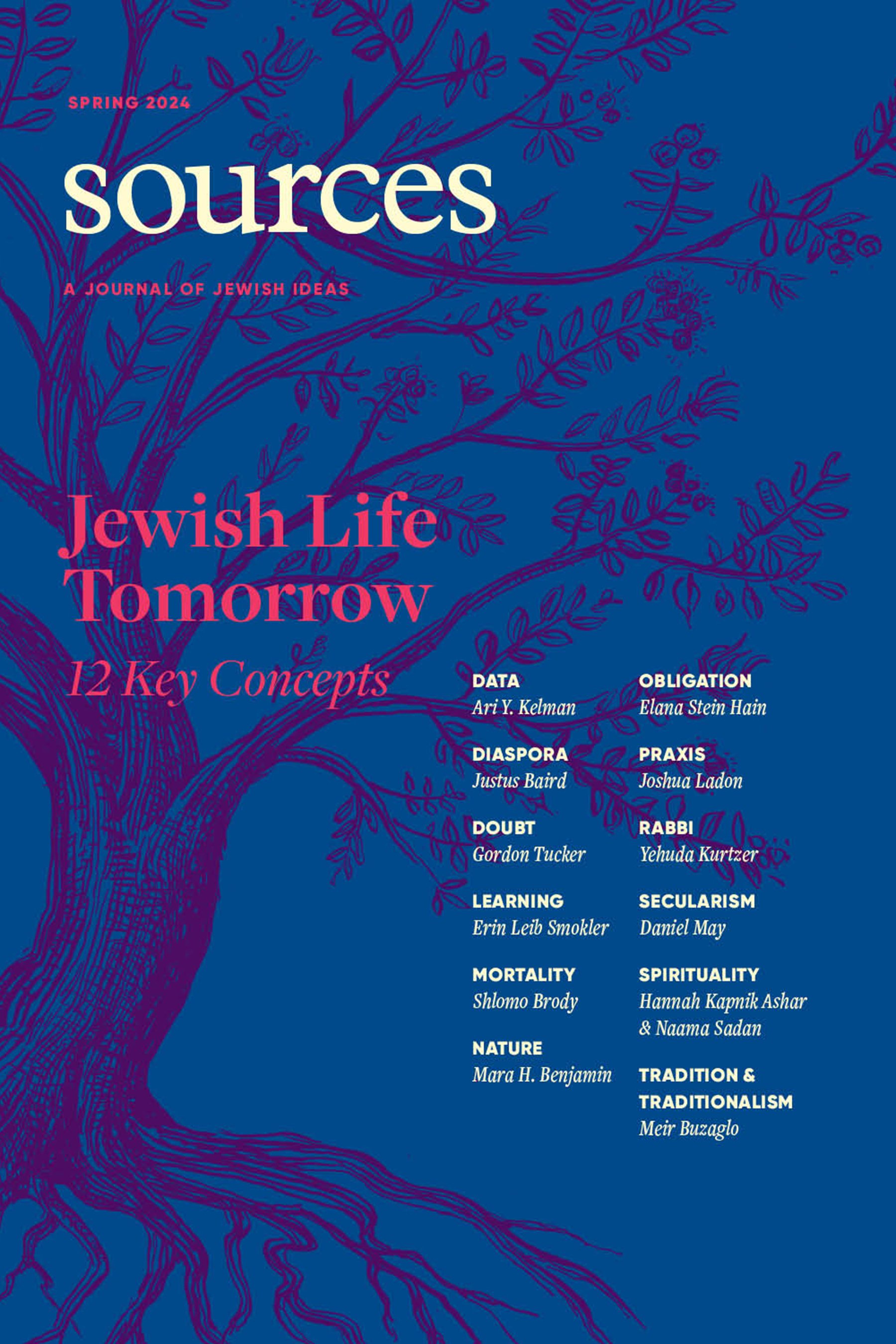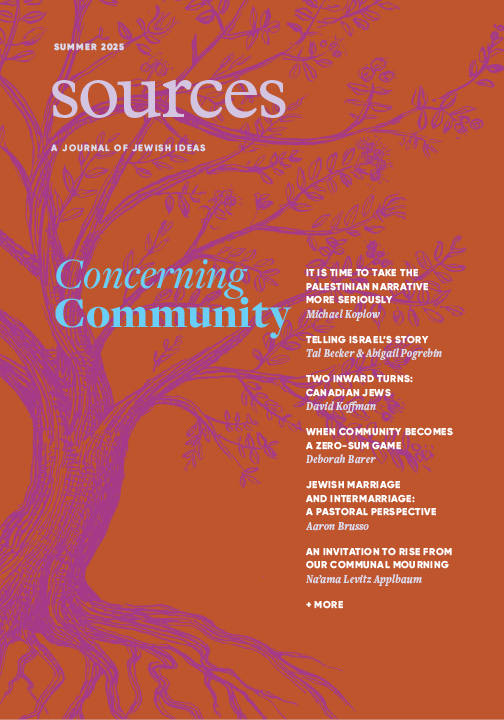Nature
Mara H. Benjamin
Mara H. Benjamin is Irene Kaplan Leiwant Professor and Chair of Jewish Studies at Mount Holyoke College.
What comes to mind when we picture Nature?
We may immediately remember a hike in the woods, a vacation spent off the grid in a remote cabin among the evergreen trees, or paddling a kayak as loons call. Nature is a destination for which we prepare ourselves, bringing a compass, a backpack, and water. Or perhaps we think of Nature as the place where mosquitos and black flies buzz in our ears, where we contend with the lack of indoor plumbing or electricity and long to return “home.” At other times, Nature appears as an enemy, coming at us with its terrifying and destructive force: in hurricanes, wildfires, and floods. Nature is, in other words, a place we visit or something that visits us. But in every case, Nature is “out there.” We gaze upon it; we go into—and then come out of—it; we run from it. We seek to understand it; we wonder at it; we find it inscrutable. At times, we may feel ourselves at one with Nature… but then we pack up, go home, and return to our day jobs.
But who is this “we” who encounters Nature? Whoever it is must exist outside of Nature. How would it be possible to visit, contemplate, or gaze upon Nature if not from a remove?
This “we” is, of course, the Human: a unique being, distinguished in kind from other creatures. Until quite recently, it was manifestly evident that the Human has a monopoly on civilization (culture, art, morality) and advanced capacities (for consciousness, sentience, language). This was common knowledge: the Human is different; the Human is set apart from the muck and baseness of “the animals,” to say nothing of other forms of life and non-life, everything else given or created in the world. Plants, landscapes, bacteria, weather events, and (non-human) animals: they share, if nothing else, a lack of these Human hallmarks.
Ecological disaster has destabilized this way of thinking, revealing it to be a particular construction that makes it hard to see the world as it is. As Bruno Latour argues in Facing Gaia: Eight Lectures on the New Climatic Regime, Nature should not be regarded as a generic term. Rather, Nature designates a collection of non-human actors and phenomena imagined as fundamentally passive and inert; those who mold, shape, and extract resources from Nature are called Human. (I have capitalized Nature and Human to indicate these terms as marked rather than neutral.) Nature and Human are interdependent constructs that only have meaning as two halves of a whole. That steady, eternal, clockwork realm of Nature “out there”? The fully agentic, detached Human observer? All of it is a chimera, a fairytale spun by the architects of Western modernity’s science, philosophy, and politics and imagined as true by those of us who have benefited most (at least in the short term) from the story. Ecological crisis exposes the Earth once again as it truly is: active, local, limited, sensitive, fragile, trembling, and easily irritated, as Latour has put it.
Often without even realizing it, many, if not most, Jews today imagine our own tradition to authorize and validate the modern view of reality divided into Nature (or “World”) and Human. We see this assumption when Jewish environmental organizations appeal to audiences to “care for nature” or “take responsibility for the environment.” It shows up in modern Jewish thought and philosophy, as, for instance, when Franz Rosenzweig’s Star of Redemption names the constituent elements of reality as “Gott, Mensch, und Welt” as if God and the Human Being were somehow outside of the World.
But it is not just that contemporary Jews imagine the tradition to authorize this construction of the world. While Jewish classical sources portray human creatures’ agency as contingent, in contrast to how many modern Western philosophers would imagine it, the presumption of human exceptionalism—that humans are “differently different” from other creatures in some fundamental respect—is baked into its earliest and most influential strains. Jewish thought, as many of us today know it, is nurtured in the soil of Jewish textual corpora. But if these corpora consistently divide the world into basic units of human and non-human—which give way to other hierarchical distinctions within the human class—how can we engage in the kind of conceptual world-construction we need?
Think for a moment about the title of this journal, Sources. The title gestures toward the authoritative textual bequest of centuries of Jewish philosophy, interpretation, legal reasoning, and more. When contemporary thinkers invoke that textual inheritance, they build from these sources. This approach is as ingrained for me as it is for most Jews I know who work explicitly with the intellectual contradictions and opportunities of (post)modernity. Our standard opening move in the game of contemporary, constructive Jewish thought is to turn to the textual storehouse, and if we disengage from those sources, the result won’t be, or won’t be perceived to be, Jewish thought.
This approach, of course, has an ancient pedigree. Even in the face of extreme discontinuity, when the Second Temple was destroyed, the new leadership insisted on asserting continuity. The sacrifices, the priestly order, the Temple itself: all remained alive and well in the rabbinic textual imagination. On a few occasions, the sages permitted themselves an acknowledgement of the fact of abrupt and traumatic rupture. But they sallied forth nonetheless, confident in the capacity of their tradition to weather even this storm: think of Rabbi Yohanan ben Zakkai’s assurance to Rabbi Yehoshua in the ruins of the Temple that acts of kindness deliver the same atonement as the sacrifices once had (Avot deRabbi Natan 4:5). This is the gesture Gershom Scholem characterized as the generative core at the heart of Jewish intellectual life, where sacred text is molded and stretched into new shapes for new situations.
Love Jewish Ideas?
Subscribe to the print edition of Sources today.
When it comes to thinking about Nature, or any other contemporary concern, my own temptation is to consult Ecclesiastes or Job, those rich texts of the Wisdom literature that decenter not only Torah but also humans. Others have turned to Kabbalah (David Seidenberg, Kabbalah and Ecology); Talmudic midrash (Julia Watts Belser, Power, Ethics, and Ecology in Jewish Late Antiquity); and other classical sources. Though I cannot speak for anyone else, I imagine that many of us turn to those sources not only because they have become our areas of scholarly expertise, but also because we regard these materials as our own, because we have become comfortable within their spaces. In addition, these sources telegraph a project’s Jewishness to others with whom we wish to be in conversation. Displaying some kind of relationship to the Jewish textual past marks us and our thinking as Jewish. Without this link, how could it be Jewish?
But I fear that this moment in the history of our planet has broken the creative tension upon which the whole enterprise of Jewish intellectual production has balanced for centuries. The gap is too vast between how we construct the world using “Jewish sources” (in this normative textual sense) and how we are coming to understand the world we inhabit now. Not only can we no longer claim to be the Human of Western modernity, gazing pacifically out at Nature from a distant shore, or only through the lenses of telescopes and microscopes; neither can we claim the exceptionalist status accorded to ha-adam in even the most radical Jewish texts. Today, we know that our species is not the only form of sapient being; other life-forms—and not just other animals—communicate, care for one another, and plan ahead.
We also now know that our species, as beings among other beings in the living world, we inhabitants of this planet, are bound to it, dependent on countless other species, including the myriad life forms inside of us, like the bacteria and other microorganisms that enable us to eat and think and move. Climate change turns us into more-than-humans; it makes us Earthbound. We are dependent: on fresh water, breathable air, a biodiverse landscape, and non-human agents and phenomena with whom we constantly interact, and who interact within us.
In the face of this knowledge, Jews need to think differently about ourselves and about the process by which we rise to meet the great catastrophe. First, we must recognize the insufficiency of our current theological vocabulary. The words from our textual canon, melo kol haaretz kevodo (the whole world is full of God’s glory) or, in a Hasidic vein, ein od milevado (there is nothing but God), do not do justice to the world’s lifeforms and their interactions in their particularity: the Hawaiian bobtailed squid and its dependence on a complex assemblage of microbes, as documented by Margaret McFall-Ngai in Arts of Living on a Damaged Planet; the storied history of a colony of penguins in Sydney Harbour that Thom van Dooren chronicles in Flight Ways: Life and Loss at the Edge of Extinction; the crocodile that mauled feminist philosopher Valerie Plumwood; the tiny coronavirus powerful enough to reshape the habits and lives of billions of humans. Our religious imagination must be able to name, acknowledge, and think with mycelium networks, as does Merlin Sheldrake in Entangled Life. We have been making do with magic markers when what we need is an infinite array of well-sharpened pencils.
Second, we must deliberately, explicitly, self-consciously understand ourselves to be entangled with and inextricable from the many others we contain and the many others with whom we have come to exist. As such, we are caught up in the inexorable planetary crisis that recognizes no national borders and has no use for a chosen people, a crisis already here for some of us but coming for all of us. We are causally connected to the depletion of fresh water that hollows out the land. Our lifeways have poisoned the air we need to live, making it unbreathable for many of us in North America this past summer, just as it has already been poisoned for many others. The economic development that has made life comfortable for some of us—I include myself and my communities—has been bought at the expense of mass extinctions, depleted soils, poisoned bodies, and vanishing homes. Yet many Jews in North America cling to a narrative that positions ecological catastrophe as a possible and preventable future rather than a very real present for many humans and non-humans alike.
Finally, Jews must begin to recognize ourselves as earthling Jews and, as such, to understand our position in the world more capaciously. Rather than glossing the “Jewish” as “that which is not a characteristic of or shared by other humans,” we must conceive of the Jewish as overlapping with and including the carbon-based, the organic, the earthly, the species. This means that the sources through which we construct Jewish thought cannot be limited to a narrowly defined corpus of textual materials. Our sources must be textual and non-textual; they must be gestural, aural, embodied. Our sources must not only be those developed by rabbis but also those developed in mycorrhizal networks of fungi. The folk medicine of unlettered Jews and non-Jews, the crocodiles that see us as prey, the deadly heat waves, the low water level of the Colorado River, the fury of Hurricane Katrina: these too must be Jewish sources. To become Earthbound, Jews can no longer allow the question “but what makes it Jewish?” to constrain Jewish thought. Rather, we must imagine Jewish tradition as the ongoing work of a group of sapient creatures entangled with others, work that might yet bear wisdom in unexpected places if we have the creativity and courage to coax it forth.




